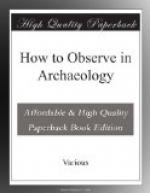No information about papyri is given here, for the reason that any site containing them should not be touched except by a trained excavator.
[ILLUSTRATION XIII: EGYPTIAN POTTERY TYPES]
CHAPTER VIII
MESOPOTAMIA
[See the diagrams of flint implements, Illustration II; pottery and brick-forms, Illustration XIV; cuneiform signs, and other scripts Illustration XV].
Mesopotamian antiquities are nearly always found in Tells, or artificial mounds, which are the sites of ancient towns or temples. The surrounding plain for a distance of several hundred yards out, whether steppe-desert or untilled land, will usually be found to be productive of antiquities, either a few inches or few feet deep or, in the case of the dessert, actually lying upon the surface. These are usually the result of rainstorms washing out antiquities from the tell itself. Each tell or ganglion of connected tells usually has a number of small subsidiary tells round about it, the sites of small isolated buildings or villages connected with the central settlement. Originally the settlements were built upon natural rises of the ground which stood up as islands in the fen-country.
Visitors should give the local names of tells in Arabic characters, when possible, so that mistakes in transliteration into English may be avoided. Antiquities bought in the neighbourhood of a tell should be noted as coming from that neighbourhood. Depredations by Arabs (or by others!) should be noted, and reported to the nearest Political Officer or Inspector of Antiquities. The barbarous practice of forcibly dislodging inscribed bricks from walls, as trophies and ‘souvenirs’, which has unhappily been common during the war, should never be imitated and always discountenanced as much as possible.
Other good spots for antiquities than tells are rare. In the mountainous and stony country of the North we may meet with rock-sculptures, as at Bavian, and these should always be recorded by a traveller, even if he is not certain that they have not been remarked before: something new may turn up at any time. Antiquities acquired in the neighbourhood of such monuments should be noted, and their precise place of origin ascertained, if possible, as in this way the site of some ancient settlement adjoining the monument may be identified. The open ruin-fields, or Khurbas, characteristic of Palestine are not usual, except in the case of Parthian or Sassanian palace ruins such as Ctesiphon, Hatra, or Ukheidhir, which were often abandoned almost as soon as they were built, so that no later population could pile up rubbish-heaps or graves above them.




